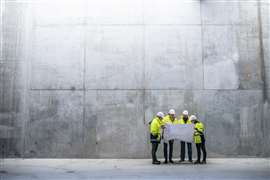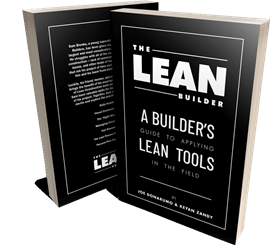‘Construction rewards last-minute firefighting - there is a better way’
06 November 2023
 Image: Halfpoint via AdobeStock - stock.adobe.com
Image: Halfpoint via AdobeStock - stock.adobe.com
Does construction have a culture of rewarding firefighting and pulling situations back from the brink?
And if so, could embracing lean construction principles lead the industry along a better path?
Those are some of the questions Keyan Zandy – now CEO of Texas-based contractor Skiles Group and winner of this year’s Lean Construction Institute Pioneer Award – found himself asking as he grappled with a troublesome project early in his career.
“It was a multi-phase project, and we got behind schedule in the first phase,” he recalls. “We worked 70 days straight to get the project back on schedule.
“I got big praise from my project manager. I got an ‘attaboy’ from my client executive, and I was even acknowledged at our company picnic.”
But such was the stress of the experience that Zandy remembers thinking to himself, “I am not sure if I am cut out for this business.”
Having heard about Lean principles and in particular how adopting them had benefitted the manufacturing world, Zandy started researching how a change in approach might help him on the next phases of the project.
Slowly, he started implementing some Lean tools and processes, including the Last Planner System.
The latter phases of the project went off without a hitch. But the reaction from his superiors was curiously muted.
“We finished on time, using very little overtime, and with much higher morale. But what was interesting was that I got no executive reach-out. Nobody called me. There was no big praise.”
Reshaping construction’s culture
It was the difference in those reactions – praise when disaster had narrowly been averted, compared to indifference when everything ran smoothly – that prompted Zandy to embrace Lean construction principles and try to change the culture of the industry.
“We reward the pull-it-out-of-the-ditch heroics and we don’t really reward planning. And so from there, I started thinking that, no, I am cut out for this business, but I want to reshape it and help be a part of a movement to reframe the way we work and think,” he says.
Zandy started attending the Lean Construction Institute’s Congress, presenting on what worked for him, finding mentors and understanding what works for them.
What is lean construction?
Zandy sums up lean construction as being about three things: Respect for people, adding value and reducing waste, and making continuous improvements.
 Keyan Zandy (Image supplied)
Keyan Zandy (Image supplied)
“A lot of times in the construction industry because of all the different organizations working together under stress and contracts with tight deadlines and budgets, people forget the platinum rule. And that really is just treating people with respect,” he says.
When it comes to reducing waste, he adds, “If you’re thinking about a job site, the only true value on that project is when a skilled craftsperson is putting work in place. The goal of that person’s foreman, the general contractor, superintendent, the architect, the owner, all the way up the line should be to make it as simple as possible for that crafts professional to put work in place.
“Unfortunately in our industry, because of the contracts and the different competing interests, sometimes we make it as hard as possible.”
Meanwhile, he describes continuous improvement as his “favourite” of the three.
“It’s looking for the things that bug you and just asking yourself, is there a better way to do it? And then just working on small steps to improve a process or a procedure or an action just a little bit better.”
Over time, Zandy argues, this can lead to big improvements.
“In our industry, there’s a lot of sentiment around saying ‘if it’s not broke, don’t fix it’, or ‘this is the way we’ve always done it’. In reality, we need to have a growth mindset where we’re constantly looking to innovate and improve,” he says.
The benefits of Lean construction principles
Having moved to Skiles Group nearly 10 years ago, first as director of operations and now as CEO, Zandy says he started to use lean principles and methodology not just on the job site but also in how the company is structured and the processes it employs.
“We started value mapping protocols and processes. And so from there, in the last nine years our firm has really grown almost five times its size. And a lot of that I attribute to lean methodology and lean culture,” he asserts.
At the same time, team morale better, he claims. “We’re really focusing on building relationships based on trust, accountability, and mutual respect. So the way we bring our trade partners into our daily huddle meetings and how we interact and how we align ourselves around the schedule is really built on, that culture, which immediately improves the morale on the project and the awareness around the construction schedule,” he says.
How to get started
A question Zandy often finds himself being asked by other construction professionals when it comes to lean construction is “where do we start?”
 Zandy and Joe Donarumo have written a book called The Lean Builder (Image supplied)
Zandy and Joe Donarumo have written a book called The Lean Builder (Image supplied)
“They’re thinking I am going to say something about the job site. But in reality, I ask them about a simple process in their office, like how they invoice their clients,” he says.
“Let’s say if I talk to one of their project managers and they describe one process, and I talk to another project manager and they describe a different process – if multiple people have different answers or it is not documented anywhere, then it is not really a process,” he says.
“And so what we like to do in our own firm, is we bring a lot of folks together from the different departments and we kind of whiteboard what the current state is of, for example, how we invoice a project. Then we try to make sure we’re all on the same page of what the current state is. Then we start working on, well, what could a future more efficient state be? And once we develop that, we put a version number on it, we issue it out, we train everybody, and now we have everybody aligned on doing things the same way. And then that team, as they’re doing it, starts to continuously improve and try to figure out is there another efficient way?”
He advises talking to people within the business about what things are annoying to them about their work, what does not seem efficient, and where the small wins are. Once those small wins are in place, then companies can move on to larger targets.
Zandy has also co-written a book with Joe Donarumo called The Lean Builder, in the style of a business fable.
“The purpose of it was to provide field leaders, project superintendents and foremen with an easily understood resource to try to get this value in the field they’re missing and to help them not have a better work life balance,” he says.
“In our industry right now, we’re leading in cardiovascular disease, we’re leading in substance abuse. We have one of the highest suicide rates. There’s a ton of mental health issues. And I feel like a lot of that has to do with the stress and the long hours and what it takes to complete the work.
“Our work has gotten a lot harder. And what’s missing is a system of how to get everybody aligned and on the same page and how to add the most value on the job site so we can work more efficiently. And so the book really outlines the Lean Construction Institute’s Last Planner System, but it’s told as a story based on our real experiences.”
Keyan Zandy on winning the LCI Pioneer Award
“I’m extremely humbled and honoured. I appreciate but usually to me, the work is what’s important.
“But this one really means a lot to me. I am really excited about it but I don’t see it as just my personal contribution.
“It is the people in Skiles Group who are actually the leaders in the field, who are implementing these tools and processes and who are making this change. I really feel like I share the award with them.”
STAY CONNECTED



Receive the information you need when you need it through our world-leading magazines, newsletters and daily briefings.
CONNECT WITH THE TEAM








